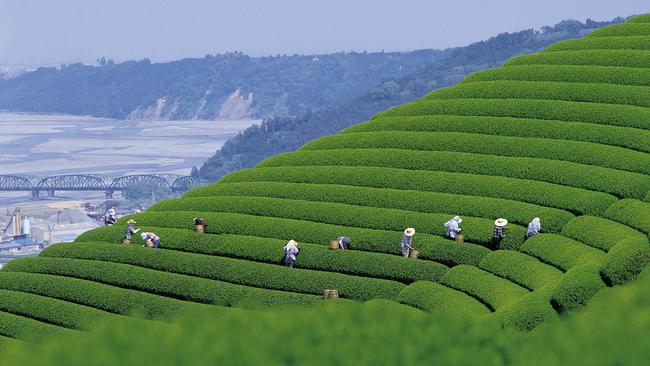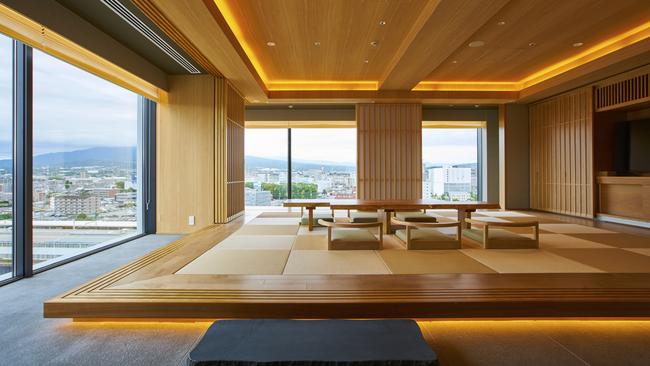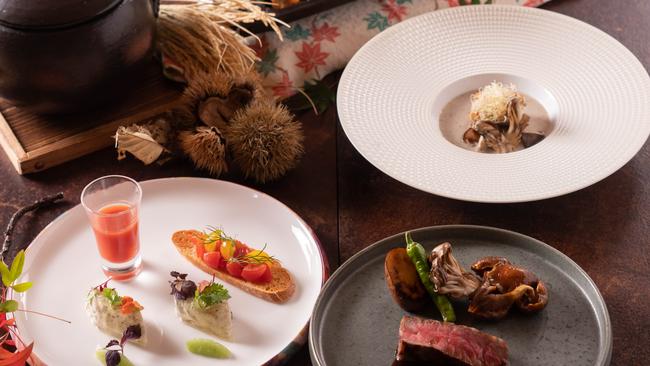Why Shizuoka is Japan’s slice of culinary heaven
Japan’s most famous mountain is central to the culinary delights of this coastal prefecture.

As tea houses go, this one’s rather minimalist, even for unostentatious Japan. But although it’s merely a wooden platform tucked into a hillside, rituals are observed, and we remove our shoes before sitting cross-legged at a low table holding three glass infusers. Each contains leaves from the bushes surrounding us, but they don’t become tea until Takuya Shigeta adds “the lotion”.
Shizuoka, a coastal prefecture an hour west of Tokyo, is culinary heaven, and everyone, from farmer to provedore to chef, knows it’s all down to its standout physical feature, Mount Fuji. This pile of volcanic scoria absorbs a mountain of rainwater and snowmelt, filtering it through underground aquifers to release its goodness from springs all over the countryside. Hence the oxygen-rich water is revered as the lotion, and the likes of tea and wasabi growers, eel farmers and sake brewers believe it makes theirs the best.

This includes Shigeta, a 15th-generation planter in charge of his family’s Ihachi Farm. Tea Terrace in the Sky – spectacularly perched 450m above the prefecture’s coastal capital, Shizuoka City – offers a chance to experience some of the six varieties they produce. From the first infuser comes a blend of roasted brown rice and green Sencha, smoky and so smooth. The other two are varieties of Yabukita, green and black. For the latter, Shigeta uses boiling water, but the green requires “just 80C”, he says. Too hot and it’s bitter.
But even 80C is overdoing it when Yasuhisa Iwazaki curates a tea-pairing meal at Nasube restaurant in Shizuoka City. Iwazaki, who’s been in the tea business for 25 years, believes his choices are “perfect”. An aperitif of green tea stalk with yuzu peel is served cold alongside salmon, while sashimi is accompanied by green Machiko leaves, served at 60–70C, to suppress the caffeine. The most intense drink is the shot, which involves pressing an ice cube into hand-rolled green leaves, and repeating the process whenever we want a dribble of icy intensity to complement the sukiyaki.

Iwazaki’s technique is masterly. When making dark green Kakegawa, he feels the pot to gauge when it’s ready to pour, then begins with just a dash to each cup, repeating constantly for consistency, “so everyone gets all the layers”. We finish with Hojicha, a pale green tea roasted at the table. Most fascinating are the steeping times. Iwazaki gives some teas 90 seconds, others get 30-40 seconds. With the Hojicha, it’s over in 10.
Shizuoka produces 40 per cent of Japan’s tea, mostly on small family plantations like Shigeta’s, that grow tea bushes where otherwise there’d be rice. Not that the grain doesn’t belong here, because Toshikazu Makino is adamant: “Great sake is made in the rice paddy.” A stalwart of the brewery his forebears established in 1743, Makino grades his rice by sight, often examining individual grains. Some is grown on his elevated property above Fujinomiya, to create a single-origin offering, while bought-in rice is used in his blends. The water, naturally, is from Fuji, piped in from a spring.

After a brewery tour, visitors can repair to the tasting room, but we’re going one better. At Tachibana, an exquisite ryokan in Fujinomiya, Makino is guiding us through a sake-paired lunch. The aperitif is Junmai daiginjo, served slightly cold to bring out the rice’s flavour and aroma. It’s teamed with a plate of bites, such as beancurd, persimmon and smoked salmon sushi, and a quail egg cut to resemble a rabbit. The Genshu, strong at 20 per cent alcohol, goes well with prawn, as it refreshes the mouth, while Makino declares his Special Junmai-shu to be “perfect with sashimi”, as its smoothness complements the fishy texture.
Although wasabi grows wild all over Japan, Shizuoka was the first to cultivate it, 400 years ago. And on the geologically marvellous Izu Peninsula south of Mishima it, too, is the domain of small farmers, who get around their steeply terraced plots on motorised planks running along single rails. Our tour also stops at a shrine near the town of Shuzenji, where locals give thanks to the god of water – not Fuji’s, as the Izu has its own volcanoes.

At the Izu Wasabi Visitor Centre, guide Chieko unveils its secrets. The vital part, she explains, is the rhizome, which can sell for about $35 at market. Then we have a taste journey, starting with a commercial tube of green paste, which is sharp and coarse, because it’s actually 95 per cent horseradish. A generic wasabi is smoother and sweeter, then we try the genuine Izu stuff, opening up a world of possibilities. Freshly grated rhizome – always produced using a circular motion, Chieko advises, never up and down – accompanies a fish cake mixed with sake, before we’re off on a tangent, having it on camembert. Then someone suggests wasabi on pizza, and the funny thing is, nobody laughs. The tour finishes with a lovely sidelight where, in a kitchen behind an organic grocery and in seemingly no time at all, we make our own tofu.

It’s not the season for a delicacy found only in Shizuoka’s Suruga Bay, the feted sakura shrimp, aka the cherry blossom shrimp because it’s pink. Fortunately the prefecture is never out of eel, although a lot is imported, but we’re told we’ll always find the real deal in eel-centric city Mishima. In certain months, these wrigglers are wild-caught, something any good restaurant will spruik. It’s also farmed, which should be no hindrance to the quality, because Shizuoka originated large-scale eel aquaculture, and if it comes from that wonderful volcanic water, you can’t go wrong.

In the know
Shizuoka food experiences can be most immersive with an English-speaking guide. Follow the Activities link at Explore Shizuoka.
Find Experiences In Japan offers tea experiences around Shizuoka City.
Fujisan Mishima Tokyu Hotel makes the most of its Fuji-facing downtown location, siting its open-air onsen on the 14th floor for fine mountain views. Ditto the excellent Robata Grill one floor below, with its excellent fusion of local and Western flavours.
In Fujinomiya, Tachibana ryokan has Fuji views and, proudly, recent Japanese
royal patronage.
Jeremy Bourke was a guest of Tourism Shizuoka.
If you love to travel, sign up to our free weekly Travel + Luxury newsletter here.



